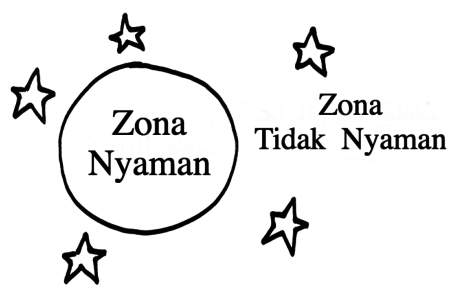The idea in this tool is to help people affirm what they already know how to do – what is in their “comfort zones”– but recognize that to learn something new they have to be in their “discomfort zone” — where the group tries new behaviours. This exercise is a playful, physical way to demonstrate this concept.
Running the exercise
Make a large circle on the floor using masking tape or a large rope. The circle should be large enough that all the participants can comfortably move inside the circle. There should also be enough space outside of the circle for all the participants.
Get everyone standing inside the circle. Then, explain that this circle represents their comfort zones.
You can do this activity with different prompts, depending on your goal:
- tactics that we have done
- tactics we know about
- skills of organising
- attitudes/emotions/behaviors that they are currently doing in this training.
For example, you could tell people to “think about some tactics that you know about that you are comfortable doing.” Then as someone calls out something, if other people agree, have them stand next to them. Make this quick. Don’t dwell too long on any single item.
As people name things, make quick observations. For example, what might be in one person’s comfort zone might not be in another person’s, or what is comfortable at one moment might feel different in another context.
After about five or six items (after the concept of the comfort zone is clear), explain that things outside of the circle are in their discomfort zone. Again, have participants name things outside of their comfort zones. As people name things, if others feel similarly have them step outside of their comfort zone (the circle), too.
Encourage the group to notice their personal feelings. Then have everyone step back into their comfort zones.
Ask people to briefly reflect: “How was it when you stepped out?” “Did anyone worry that nobody else might join them? How did that feel?” Again, just seek quick reactions. This is a bad time for long talking or long intellectual arguments. If they go down that road, go back to the task: invite another person to identify something outside their discomfort zone.
(After a handful of items) “What’s the value of stepping outside of your comfort zone?”
Draw key points from the group about why stepping out of the comfort zone is valuable.

Explain the concept: Learning takes place when individuals and a group step out of their “comfort zone” into their “discomfort zone”. That is when you are stretched to experience a new thing, and reflect on it. And, once someone survives a trip into their discomfort zone, their comfort zone is enlarged. She or he knows they can do that thing again. This is a pro-learning attitude. We take risks (by stepping outside of our comfort zones) and allow ourselves to learn and try new things.
Invite the group to reflect on what are some actions outside of our discomfort zone we might want to try out? The group can go directly into planning or trying out new behaviours. Encourage the group to notice when they step outside their comfort zone and support each other in doing so during the rest of the meeting/training.
Trainer’s Note: The concept of “comfort zones” and “discomfort zones” is different than building a container (or “safety”) for the group (See How to Build Safety in a Group). If the facilitator and group do a good job of building a container, then the participants will frequently go out of their comfort zone in order to stretch and grow. Allowing feelings of discomfort can, therefore, be one sign of a strong container in a group. We encourage participants to consciously take risks or challenges that step outside of their comfort zones.